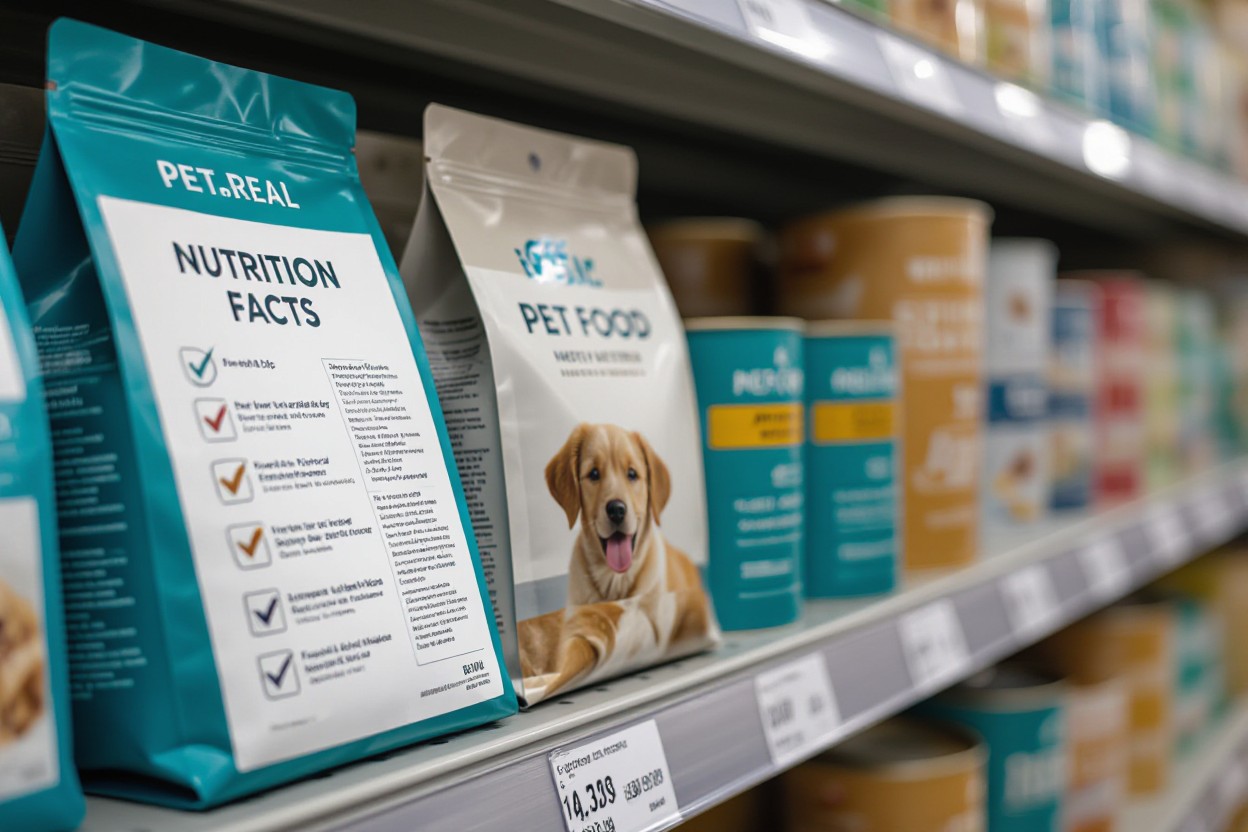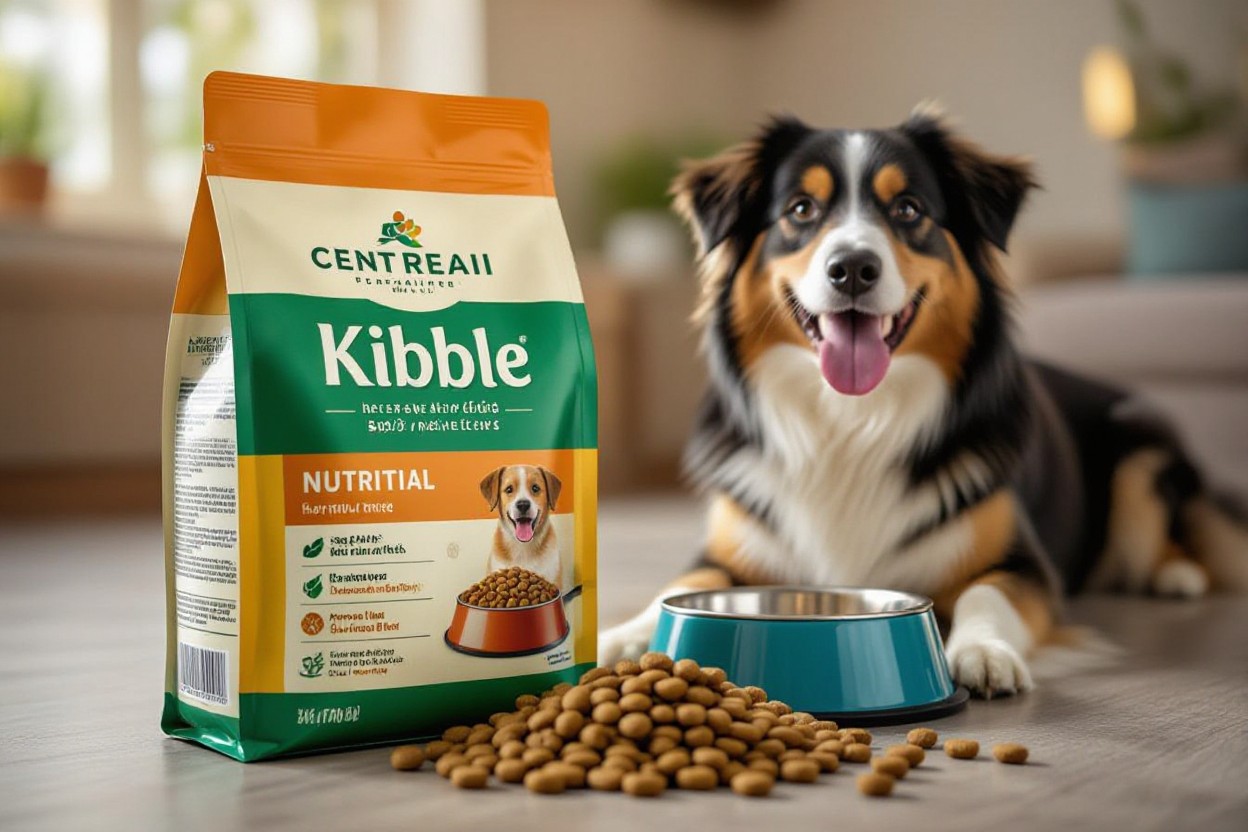Overwhelmingly, when you choose pet food you should focus on the AAFCO statement and guaranteed analysis to ensure nutritional adequacy; check ingredient lists so you can avoid toxic additives and ambiguous by-products and favor foods with named, high-quality protein sources. Also look for feeding guidelines, calorie info, and manufacturer contact details so you can compare options confidently and protect your pet’s health.
Key Takeaways:
- Ingredient list is by weight — the first items are the largest; prefer specific named proteins (e.g., “chicken”) and watch for vague terms like “meat by-products” or excessive fillers.
- Check the Guaranteed Analysis and calorie (kcal) info to compare protein/fat/fiber levels and determine portion sizes; feeding guides are starting points and should be adjusted for your pet’s weight and activity.
- Look for an AAFCO statement indicating the food is “complete and balanced” for the appropriate life stage, and scan the label for additives or common allergens.
The Importance of Understanding Pet Food Labels
Parsing the label lets you spot gaps that affect your pet’s health: check the guaranteed analysis for protein/fat percentages, the AAFCO statement for life-stage suitability, and feeding guidelines to avoid overfeeding. You can prevent specific issues—feeding an adult cat food low in taurine raises risk of dilated cardiomyopathy, while excess calories drive obesity. Compare kcal/kg or kcal/cup across brands to adjust portions for your pet’s age, weight, and activity.
Nutritional Requirements of Pets
AAFCO nutrient profiles set minimums you should expect: adult dogs 18% crude protein, growth/reproduction 22%; adult cats 26%, growth/reproduction 30%. You must also ensure vital nutrients—cats need taurine and arachidonic acid, puppies and kittens benefit from higher DHA for brain development. Look for explicit life-stage claims and the AAFCO feeding trial or formulation statement to confirm the formula meets those targeted requirements.
The Role of Ingredients
Ingredient order reflects weight before processing, so the first five ingredients matter most; fresh meat can be listed first but contains ~70% water, while a named meat meal like chicken meal is concentrated protein and often provides more protein per pound. Watch for vague terms such as “meat by-products” vs named organs or meals, and note preservatives—mixed tocopherols are a positive alternative to synthetic BHA/BHT.
Label qualifiers change meaning: terms like “with” often indicate single-digit percentages (around 3%), while “dinner/entrée/formula” typically imply a larger share (commonly ~20–25% of the named ingredient). Be aware that grain-free formulas high in peas/legumes drew FDA attention due to associations with reported canine dilated cardiomyopathy cases; if your dog has risk factors, you may prefer diets with traditional grains or seek veterinary guidance.
Key Components of Pet Food Labels
Guaranteed Analysis
Guaranteed Analysis lists nutrient minimums and maximums on an as‑fed basis. Typical dry dog kibble might show: Crude Protein (min) 25%, Crude Fat (min) 12%, Crude Fiber (max) 4%, Moisture (max) 10%. Convert to dry‑matter to compare products — 25% protein at 10% moisture becomes ~27.8% DMB. You should use the dry‑matter conversion to compare cat versus dog formulas and wet foods versus kibble; look also for AAFCO statements that verify nutrient profiles.
Ingredient List
Ingredient lists are ordered by weight before cooking, so fresh meat can appear higher even if it shrinks during processing. You should look for named proteins (e.g., “chicken” or “salmon”) or concentrated sources like “chicken meal.” You should avoid vague terms such as “meat” or “meat by‑product” if you want predictable protein sources. You must watch treats and dental chews for sweeteners — xylitol is highly toxic to dogs.
If you compare ingredients, note fresh ingredients contain lots of water: raw chicken is about 70% moisture, so 100 g fresh yields roughly 30 g of actual nutrient mass, while chicken meal is already dry and concentrates protein. You may see manufacturers “split” ingredients (chicken, chicken meal, chicken fat) to keep a meat appearing early on the list; a product that states “contains 30% chicken” or lists a single named protein first gives clearer expectation. Check preservatives — mixed tocopherols are natural, whereas BHA/BHT have raised safety concerns.
Decoding Ingredient Labels
Ingredient lists are ordered by weight before cooking, so fresh meats (about 70–75% water) can appear above concentrated meals; you should favor named meat meals like “chicken meal” or “salmon meal” for higher protein density and be wary of vague terms such as “meat” or “animal digest.” Check the guaranteed analysis (crude protein, fat, fiber, moisture) and AAFCO statements to confirm the food meets species-specific minimums for adult maintenance.
Understanding Common Ingredients
Whole meats (chicken, beef) provide moisture and palatability, while meat meals supply concentrated protein; by-products vary in quality but can be nutrient-dense if specified (e.g., “chicken by-product meal”). Grains and legumes add carbohydrates and fiber—corn, rice, peas—but high pea/wheat content can boost digestibility issues in some dogs. Fats (chicken fat, fish oil) deliver crucial fatty acids, and preservatives range from synthetic BHA/BHT to natural mixed tocopherols.
Identifying Low-Quality Ingredients
Vague labels like “meat,” “animal meal,” or “meat and bone meal” often indicate inconsistent sourcing and variable nutrient profiles; cheap fillers include corn gluten meal, wheat middlings, and soybean hulls. High ash (>8–10%) can signal excess bone, while artificial colors/flavors and BHA/BHT preservatives raise long-term safety concerns. You should treat unnamed or overly generic ingredients as red flags.
Compare ingredient order and guaranteed analysis: if “chicken” tops the list but crude protein is low (<18% for adult dog maintenance) the product likely relies on moisture or carbs; prefer formulas listing a named meat meal within the first three ingredients. Note that fresh meat’s water can mislead labels, whereas meals concentrate protein—this explains why “salmon meal” often provides more usable protein than “fresh salmon” by weight. Past recalls, like the 2007 melamine event, show how unnamed imported additives can cause renal failure, so you should favor transparent sourcing and AAFCO-compliant formulations.

Regulations and Standards for Pet Food
Federal oversight by the FDA and enforcement by state feed officials work alongside AAFCO’s model regulations to govern pet food safety, labeling, and recalls; AAFCO’s Official Publication is updated annually and serves as the industry reference. You should track recalls and advisory notices—raw diets have prompted multiple Salmonella-related recalls—and expect mandatory elements like ingredient lists, guaranteed analysis, and a nutritional adequacy statement on any product you buy.
AAFCO Guidelines
AAFCO issues model definitions, nutrient profiles (adult maintenance; growth/reproduction), and labeling rules that manufacturers follow to claim a product is “complete and balanced.” You’ll see either an AAFCO feeding-trial statement or a formulation claim on the label; both are accepted paths to compliance. AAFCO also defines naming conventions used industry-wide, including the 95%, 25%, and 3% rules for ingredient prominence.
Labeling Requirements
Labels must include product name, net weight, manufacturer name/address, ingredient list (descending by weight), guaranteed analysis (crude protein/fat/fiber/moisture), feeding directions, and a nutritional adequacy statement. You should look for an AAFCO statement or feeding-trial claim and note lot codes or expiration dates. Watch for marketing terms—“with” or “flavor” can hide low ingredient content—and check kcal listings (many brands list kcal/kg and kcal/cup) to compare energy density.
Specific naming rules affect ingredient percentages: a product labeled “Beef” typically follows the 95% rule, “Dinner/Entree” follows the 25% rule, “with” requires about 3% minimum, while “flavor” has no minimum. Convert guaranteed analysis to dry-matter basis to compare: for example, 24% crude protein at 10% moisture equals 24 ÷ 0.90 = 26.7% protein on a dry-matter basis.
Choosing the Right Pet Food Based on Labels
Check labels for three priorities: the AAFCO statement, the guaranteed analysis and the ingredient order; adult dogs require minimum 18% crude protein while adult cats need 26%. Verify production dates and caloric density (typically 300–500 kcal per cup) to match your pet’s daily energy needs and avoid expired or poorly preserved formulas.
Factors to Consider
Compare protein sources—named meats versus meals—since meat meal provides concentrated protein; note fat minimums (about 5% for dogs, 9% for cats per AAFCO). Check calorie claims and scan for preservatives like BHA/BHT or additives and common allergens such as corn or soy, which can trigger sensitivities in some pets.
- AAFCO statement — indicates nutrient adequacy or feeding-trial validation.
- Guaranteed Analysis — lists minimum crude protein/fat and maximum fiber/moisture.
- Ingredient order — first three ingredients usually make up the bulk of the diet; prefer named meat first.
- Caloric density — kcal per cup or per can lets you calculate precise portions.
- After checking label, compare the listed kcal to your pet’s calculated energy needs and adjust portions accordingly.
Tailoring Food to Your Pet’s Needs
Adjust by life stage and health: spayed/neutered pets often need 10–20% fewer calories, while large-breed puppies need controlled calcium to avoid growth issues. A 5 kg adult cat typically needs ~200–250 kcal/day—use label kcal to set portions. For renal disease choose lower phosphorus diets; for obesity reduce daily kcal by ~20% and monitor weight weekly.
Calculate energy precisely using RER = 70 × (body weight in kg)0.75, then apply a multiplier (1.2–1.6 for inactive to moderately active pets) to get MER. If a label shows 350 kcal/cup and your MER is 700 kcal, feed 2 cups/day. Weigh your pet every 2 weeks and adjust to aim for 0.5–2% bodyweight change per week; consult your vet before using therapeutic formulas or if you spot xylitol or other hazardous additives.
Common Misconceptions About Pet Food Labels
Marketing buzzwords like “natural” or “premium” often mask meaningful differences, because there is no universal legal definition for those terms in pet food; instead you should prioritize the AAFCO statement, guaranteed analysis, and kcal information. Beware that grain‑free diets have been linked to hundreds of FDA reports of canine DCM since 2018, so evaluate ingredient balance and nutrient content rather than relying on slogans or price alone.
Marketing Terminology
You can decode common label claims using AAFCO naming rules: the 95% rule applies to names like “Beef,” the 25% rule to “Dinner/Entrée,” and the 3% rule to “With X,” while “flavor” may require only a detectable amount. “Human‑grade” and “premium” carry little regulatory weight for pet food; check the ingredient order and the AAFCO “complete and balanced” statement to see whether marketing matches actual formulation.
Myths vs. Reality
You may believe that grain‑free equals better or that higher price guarantees quality, but evidence shows otherwise: the FDA logged hundreds of reports since 2018 linking some legume‑rich grain‑free diets to DCM in dogs, and expensive formulas can still list low‑value ingredients like “meat by‑products” first. Use the guaranteed analysis, named protein sources, and the AAFCO statement to separate myth from fact for your pet’s needs.
Examine the ingredient list and convert to dry‑matter terms—fresh meat is about 70% water, so “chicken” can appear first but deliver less protein than “chicken meal”; compare guaranteed analysis on a dry‑matter basis, review calorie content (kcal per cup) for accurate portioning, verify the AAFCO “complete and balanced” statement for your pet’s life stage, and consult your veterinarian if your dog or cat has breed‑specific risks or medical conditions.
Final Words
With this in mind, you can confidently interpret pet food labels to choose age- and condition-appropriate diets, assess ingredient quality and guaranteed analysis, and compare feeding guidelines and nutritional statements; your informed decisions help maintain optimal health and prevent dietary mistakes.
FAQ
Q: How do I read the ingredient list and what does the order mean?
A: Ingredients are listed by weight at the time of manufacture, so ingredients with high water content (fresh meat, fruits, vegetables) can appear near the top even if they contribute less dry-matter nutrients than a meat meal listed later. Look for named proteins (e.g., “chicken,” “beef”) or specific meals (“chicken meal”) rather than vague terms like “meat” or “meat by-products.” “Meal” (e.g., “chicken meal”) is concentrated after moisture removal and is a dense protein source. By-products are not inherently bad—some are nutrient-rich organ tissues—but quality varies, so brands that specify source and processing standards are generally preferable. Watch for single-source protein claims if your pet has allergies, and note that additives (vitamins, minerals, preservatives) are usually listed toward the end.
Q: What does the Guaranteed Analysis tell me and how do I compare foods on a dry-matter basis?
A: The Guaranteed Analysis lists nutrient minimums and maximums (e.g., crude protein minimum, crude fat minimum, crude fiber maximum, moisture maximum). These are expressed on an as-fed basis and can be misleading when comparing wet vs dry foods. Convert to dry-matter basis (DMB) to compare: DMB % = (as-fed % ÷ (100% − moisture%)) × 100. For example, if a food lists 10% protein and 75% moisture, protein on DMB = (10 ÷ 25) × 100 = 40% DMB. Also check the AAFCO (or local regulatory) statement: “complete and balanced” and the life-stage declaration (e.g., maintenance, growth, all life stages) indicate whether the formula meets established nutrient profiles. Products stating they’ve passed AAFCO feeding trials have proven performance under test conditions; products “formulated to meet” rely on formulation alone.
Q: How should I interpret marketing claims, feeding guidelines, and calorie information?
A: Marketing terms like “natural,” “holistic,” and “human-grade” have varying regulatory meaning; “organic” and “USDA organic” are certified but apply only to ingredients that meet organic standards. Words like “with” or “contains” can be used even if the named ingredient is a small percentage; “flavor” claims can mean a tiny amount was added. Feeding guidelines on the label are rough starting points based on average activity and body condition—monitor your pet’s weight and adjust portions as needed. Look for calorie information (kcal per cup or per can and kcal/kg) to calculate precise feeding amounts. Check expiration or batch codes and storage recommendations; follow manufacturer guidance for opened-food storage and consult your veterinarian if your pet has special health, weight, or life-stage needs.
“Guess what? When you click and buy through our links, you’re helping us keep the NeuroPawz community thriving. It doesn’t cost you a whisker more 🐱, but it means we can keep fetching the best calming beds, cozy toys, and comfort tips for you + your pets. Win-win!”

